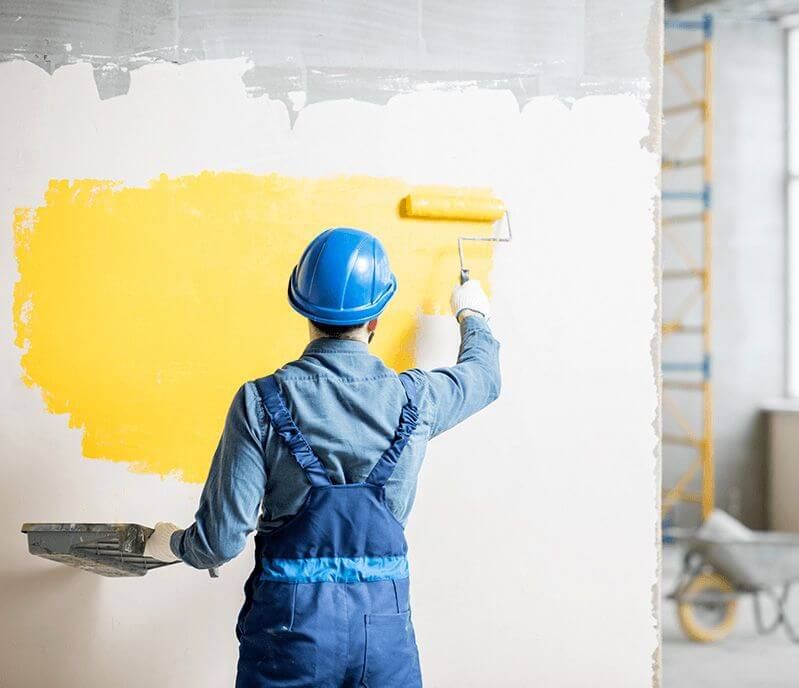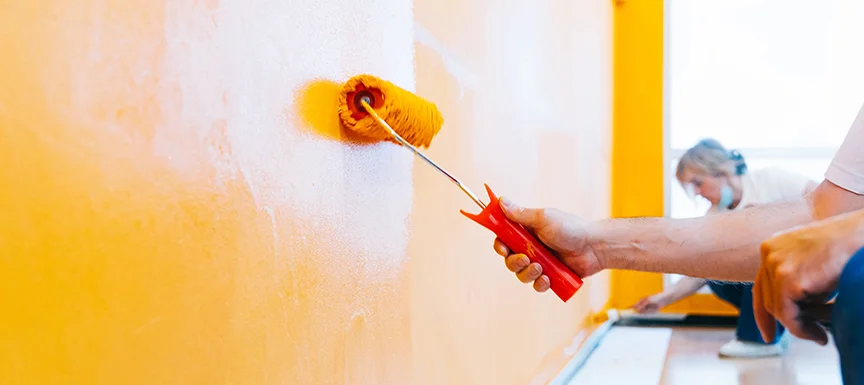Exploring the Various Sorts Of Paint: An Overview for each Job
Checking out the various sorts of paint is important for achieving the preferred result in any task. From water-based alternatives that provide comfort to oil-based paints recognized for their toughness, each selection has its values. Specialty paints can add special structures or finishes, while eco-friendly options satisfy those looking for sustainability. Understanding these distinctions can significantly impact the success of a painting endeavor. What aspects should one consider when making the ideal selection?
Understanding Paint Types: Water-Based vs. Oil-Based
Paint types can significantly impact a project's result, and recognizing the differences between oil-based and water-based paints is vital for educated decision-making. Water-based paints, often referred to as latex paints, are made up of water as the primary solvent. They dry rapidly, emit fewer unpredictable natural substances (VOCs), and are easy to tidy up with soap and water. This makes them a popular selection for interior applications and settings where air quality is an issue.
On the other hand, oil-based paints utilize organic solvents, supplying a sturdy, glossy surface ideal for surface areas subjected to damage, such as trim and closets. They take longer to completely dry, need mineral spirits for clean-up, and have a more powerful smell. paint shops in corpus christi. Selecting between these two types relies on the particular needs of the project, considering factors such as preferred finish, application setting, and convenience of maintenance. Each kind has unique benefits and restrictions, assisting the selection process
The Complete Matters: Picking In Between Matte, Satin, and Gloss
When selecting a paint finish, the choice between matte and glossy options considerably affects both aesthetic appeals and performance. Matte surfaces use a refined, non-reflective appearance that can conceal surface flaws, while glossy finishes provide resilience and ease of cleansing. Comprehending the advantages and considerations of each can aid in making an informed choice for any painting job.
Matte End Up Advantages
Although several house owners dispute the qualities of numerous surfaces, matte paint provides unique advantages that make it a popular selection for both exterior and interior applications. One of the key benefits of matte finish is its capability to hide surface area flaws, developing a smoother appearance on wall surfaces. This high quality is especially beneficial in older homes or rooms with unequal surfaces. In addition, matte paint takes in light as opposed to mirroring it, which can improve the aesthetic of a room by giving a much more soft and sophisticated appearance. Additionally, matte finishes are often much easier to repair than glossier choices, as they can mix more effortlessly when used over existing paint. Overall, matte paint is an exceptional selection for those seeking an improved and sophisticated coating.
Shiny Finish Considerations
A shiny coating can drastically modify the perception of an area, supplying a sleek and reflective high quality that improves both shade vibrancy and light within an area. This coating is often favored for high-traffic areas and surface areas like bathroom and kitchens, where durability and ease of cleaning are vital. However, its reflective nature can highlight flaws on walls, making correct surface area prep work essential. Glossy paints also tend to show smudges and fingerprints quicker, necessitating regular maintenance. Additionally, lighting plays a significant duty; in intense settings, a shiny surface may create glare, influencing the total aesthetic. As a result, careful consideration of the specific application and environment is essential when picking a shiny surface for any type of task.
Specialty Paints: When to Use Distinctive or Chalk Paint
Specialized paints, such as textured and chalk paint, offer one-of-a-kind aesthetic and practical advantages that can boost various surfaces. Distinctive paint is optimal for creating deepness and dimension on wall surfaces, concealing blemishes while adding a three-dimensional feeling. It is specifically advantageous in high-traffic areas where durability and aesthetic interest are essential.

Both kinds of specialty paints can transform rooms, yet picking the ideal one depends upon the preferred effect and surface area needs. Distinctive paint may fit larger areas, while chalk paint can renew smaller sized products, showcasing creativity and individual design in any task.
Exterior Paints: Shielding Your Surface Areas From the Elements
Exterior paints are essential for safeguarding surface areas against numerous climate condition. Recognizing their weather condition resistance attributes, correct surface area preparation demands, and reliable application methods can considerably improve durability and efficiency. This section will certainly outline vital considerations for picking and using outdoor paints properly.
Climate Resistance Includes
Climate resistance is a vital attribute of outdoor paints, as it identifies exactly how well surface areas can withstand the harsh components of nature. Top notch outside paints are developed to withstand damages from UV rays, dampness, and temperature level changes. UV resistance assurances colors continue to be vibrant with time, avoiding fading and staining. Moisture resistance safeguards versus mold and mildew and mildew, which can compromise the integrity of surfaces. In addition, paints with excellent temperature resistance can broaden and get without fracturing, preserving their protective qualities. When selecting outside paints, it is crucial to consider these climate resistance functions, as they contribute to the durability and longevity of coloured surfaces, making particular they stay aesthetically pleasing and functional regardless of direct exposure to the components.
Surface Preparation Demands
Appropriate surface area preparation is an essential action in accomplishing the ideal outcomes with exterior paints. To guarantee optimal bond and sturdiness, surfaces should be completely cleaned, eliminating dust, mold, and oil. This can be achieved utilizing a stress washing machine or a scrub brush with an appropriate cleansing remedy. As soon as cleaned, surfaces should be examined for any kind of peeling or flaking paint, which must be scratched away to develop a smooth foundation. Fixing any type of splits or openings is additionally important, as these can enable wetness seepage. Additionally, sanding rough areas advertises better paint attachment. Ultimately, applying a guide fit for exterior usage can enhance the paint's performance, assuring a durable surface that withstands the components. Proper prep work is vital to an effective outdoor painting job.
Application Strategies Tips
While using outdoor paints, it is necessary to make use of efficient strategies that assure surfaces are well-protected versus the elements. Initially, pick the appropriate day for paint; low humidity and mild temperatures improve adhesion and drying. Prepping the surface area completely-- cleansing, sanding, and priming-- makes sure better paint bond and toughness. Utilizing high-quality brushes or rollers can supply a smoother surface, while spray paint might cover large areas successfully. Using paint in thin, also coats stops runs and drips. It is advisable to follow maker instructions relating to drying times in between coats. Confirm appropriate ventilation during application to help with drying and reduce exposure to fumes. These strategies substantially improve the longevity and performance of exterior paint.
Eco-Friendly Options: Low-VOC and Zero-VOC Paints
As customers become significantly familiar with the environmental effect of their choices, zero-voc and low-voc paints have actually emerged as popular options. These paints are created to contain less unstable natural compounds (VOCs), which are chemicals that can evaporate into the air and add to air pollution and health issue. Low-VOC paints usually consist of a limited amount of VOCs, while zero-VOC paints have negligible degrees, making them much safer for both indoor and outside use.
The advantages of using zero-voc and low-voc paints extend beyond ecological factors to consider; they also enhance interior air top quality, reducing the risk of respiratory system concerns and allergies. Several manufacturers currently supply a range of shades and finishes in environment-friendly options, making it simpler for customers to find ideal products for their tasks. By selecting these paints, individuals can add to a much healthier setting while still attaining the aesthetic they desire in their rooms.
Devices and Strategies for a Perfect Application
Accomplishing a remarkable paint application requires the right devices and methods, which can considerably boost the outcome. Selecting the ideal brush or roller is necessary; brushes function well for edges and intricate locations, while rollers cover larger surfaces successfully. Making use of premium materials assures much better paint distribution and lessens touches. For excellent outcomes, surface area preparation is essential. This includes cleansing, sanding, and priming surfaces to promote bond.
Technique additionally plays a significant duty. The "W" approach with a roller helps to equally distribute paint, while long, smooth strokes with a brush avoid visible lines. Working in areas permits much better control and mixing. Additionally, using slim layers is preferable to thick layers, decreasing the threat of drips and unequal textures. Preserving a damp side throughout application assists accomplish smooth modifications in between areas. By combining these devices and methods, one can attain a expert and polished coating.
Tips for Maintaining and Taking Care Of Your Painted Surfaces
Correct upkeep and treatment of coloured surface areas can considerably prolong their lifespan and preserve their look. Regular cleaning is important; utilizing a soft towel or sponge with mild soap and water can eliminate dust and dust without harming the paint. It is recommended to stay clear of rough cleansers or rubbing pads, as these can scratch the surface. Furthermore, using a fresh layer of paint every few years can invigorate the shade and safeguard versus wear.
For exterior surfaces, checking for indications of peeling off or fading consistently is very important. Promptly attending to any issues prevents more damages. In areas prone to moisture, such as shower rooms, using mold-resistant paint and guaranteeing correct ventilation can aid preserve the honesty of the paint. Making use of protective coatings can protect against UV rays and stains, guaranteeing that repainted surface areas stay vibrant and appealing for years to come, eventually improving the overall visual of the room.

Regularly Asked Inquiries
Can I Mix Different Kind Of Paint Together?
Mixing various sorts of paint is usually not recommended, as it can bring about issues like inadequate attachment, irregular appearance, or unforeseen chemical reactions. It's finest to use suitable paints for ideal results and longevity.

How Do I Appropriately Shop Surplus Paint?
To appropriately save remaining paint, seal the container tightly, tag it with the day and color, and keep it in a cool, dry place far from direct sunlight and extreme temperature levels for perfect conservation.
What Is the Ideal Method to Take Care Of Extra Paint?
The most effective method to take care of extra paint is to examine neighborhood regulations, as many areas have designated dangerous waste facilities. Consider contributing functional paint to community organizations or colleges for their tasks.
Just How Can I Tell if Paint Is Still Excellent to Make Use Of?
To figure out if paint is still great, examine its odor, color, and consistency. If it appears separated, has an undesirable smell, or shows significant adjustments in structure, it's most likely no more usable.
Exist Age Restrictions for Purchasing Paint Products?
In many areas, there are no certain age restrictions for acquiring paint products. Nonetheless, some stores may call for customers check here to be at least 18 years old, particularly for products containing solvents or dangerous materials.
Paint types can significantly affect a project's result, and comprehending the differences between oil-based and water-based paints is important for educated decision-making. Water-based paints, often referred to as latex paints, are composed of water as the main solvent. In contrast, oil-based paints make use of organic solvents, giving a resilient, shiny finish perfect for surface areas exposed to use and tear, such as trim and cupboards. Specialized paints, such as textured and chalk paint, offer unique visual and sensible benefits that can boost various surfaces. In areas prone to moisture, such as shower rooms, making use of mold-resistant paint and guaranteeing correct air flow can help maintain the honesty of the paint.